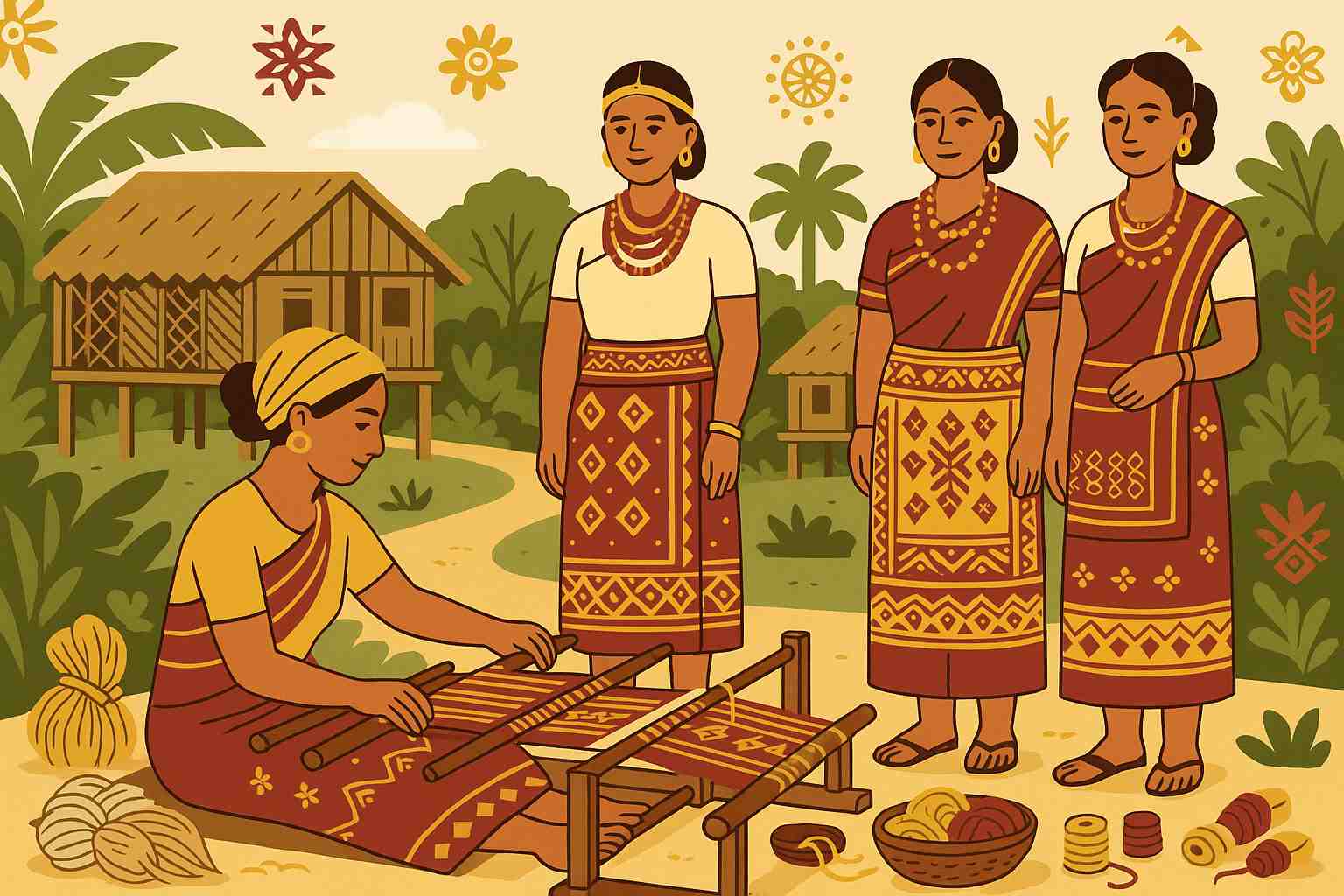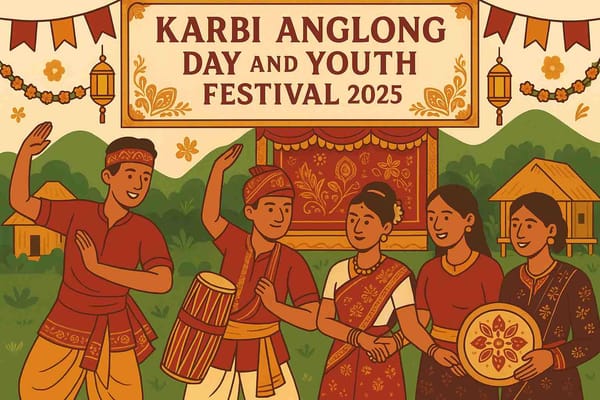
Karbi Anglong's Rich Tapestry: Traditional Dress and Weaving Techniques Explained
Have you ever held a piece of handwoven cloth and felt the stories humming within its threads? Deep in the heart of Assam, nestled amidst lush green hills, lies Karbi Anglong—a land where weaving isn't just a craft; it's the very heartbeat of the Karbi community. Their traditional attire is a vibrant tapestry, each pattern a verse, each color a feeling, telling tales of their ancestors, their connection to nature, and their proud identity.
It’s more than just clothing; it’s a living, breathing legacy passed down through generations, a treasure that deserves to be celebrated. Today, let’s take a journey into this beautiful world and understand the soul woven into Karbi textiles.
Saketa – More Than Just a Cloth, A Woven Legacy
At the core of Karbi weaving is a beautiful tradition known as Saketa. To call it just textile art would be an understatement. Saketa is a spiritual and communal practice, a way for the Karbi people to preserve their history and stay connected to their roots. The handloom is their canvas, and the threads are their words, weaving narratives of tribal folklore, the rustling leaves of the forest, and the gentle flow of the river.
What truly makes Saketa special is how it brings people together. It’s a common sight to see women of the community gathered, their hands moving in a rhythmic dance with the loom, sharing stories, laughter, and wisdom. This shared activity strengthens their bonds and fills them with immense pride. In a world of fast fashion, Saketa stands as a beautiful reminder of sustainability, using natural fibres and dyes sourced right from their backyard.
A Glimpse into the Karbi Wardrobe: Attire for Men and Women
The traditional garments of the Karbi people are a stunning reflection of their culture. You might wonder what makes their dress so unique. It’s the combination of handwoven artistry, symbolic patterns, and the deep cultural meaning attached to each piece. These outfits are most beautifully displayed during festivals and important ceremonies, painting the entire region in a riot of colours.
For the Karbi Woman: Grace in Every Weave
The attire of a Karbi woman is a picture of elegance and strength. Their wardrobe is rich with beautifully crafted pieces:
- The Pini and Pinicamflak: The Pini is a striking black skirt worn around the waist, often secured with an artistic belt. It comes in various intricate designs like the jangre, santok, and mekserek. The Pinicamflak is a lower garment, similar to the Assamese Mekhela, but shorter and incredibly graceful.
- The Pekok and Wamkok: The Pekok is a lovely upper garment that drapes beautifully, while the Wamkok is a creatively designed waistband that adds a touch of artistry to the entire outfit.
- The Dokherso and Piba: During solemn occasions like the ‘Chom-a-Kan’ (death ceremony), women wear a striped, colourful scarf called the Dokherso. And in a beautiful display of motherhood, they use a long cloth called Piba to carry their babies securely on their backs, keeping them close to their hearts.
For the Karbi Man: Simplicity and Honour
The traditional dress of Karbi men reflects a sense of dignity and a deep connection to their land. Their key garments include:
- The Choi and Chaithangpo: Young men wear the Choi-Hongthor or Choi-Apong, which are artistically designed shirts that also serve as warm jackets. The elderly men wear a special shirt called the Chaithangpo, signifying their respected status in the community.
- The Rikong and Sator: The Rikong is a simple yet dignified cloth used by married and older men, especially while working in the fields. The Sator is a dhoti adorned with symmetrical designs and animal prints, showcasing their bond with nature.
- The Poho: Though its use is declining, the Poho, a colourful silk turban, was once a proud symbol of a Karbi man's identity.
The Art of the Loom: Secrets of Karbi Weaving
Weaving is a sacred skill in Karbi culture, a gift passed from mother to daughter. The process itself is a form of meditation. The longitudinal threads, called a'tuk (warp), and the horizontal ones, known as a'rang (weft), are interlaced with immense patience and skill.
The weavers primarily use locally grown cotton and the famous Eri silk, also known as Hon-ki. The colours they use are not just for beauty; they hold deep cultural meaning. Bright hues often symbolise joy and festivities, while earthy tones represent their connection to the land. The motifs are a direct reflection of their world—flowers, animals, and geometric patterns that signify gender, marital status, and social hierarchy. Each design tells you a little something about the person wearing it.
Weaving a Future: Challenges and Hope
In today's fast-paced world, this ancient craft faces its share of challenges. The lure of modern life can make it difficult to pass on this labour-intensive skill to the younger generation, and the market is flooded with machine-made textiles. But the spirit of the Karbi people is resilient.
There is a growing movement to preserve and promote this priceless heritage. Cultural festivals like Rongker and Chomangkan provide a wonderful platform to showcase these traditions. Recent handloom exhibitions have been a great success, helping identify talented weavers and connecting them with designers and a larger market. This incredible effort to preserve a region's identity is a story that echoes across India, much like in the preservation of Udaipur's rich tapestry of art and craft.
Many now wonder if it's possible to buy these beautiful garments online. The answer is a resounding yes! Digital platforms have opened up a new world for these artisans, allowing them to sell their creations globally. When you choose to buy authentic Karbi textiles, you're not just purchasing a piece of cloth. You're supporting a weaver's livelihood, honouring their skill, and helping keep their culture alive. To ensure you're getting a genuine piece, always look for the tell-tale signs of handloom work and, if possible, buy from sources that directly support the artisan community.
Honouring Karbi Anglong's Timeless Craft
The traditional dress and weaving of Karbi Anglong are more than just cultural artifacts; they are the woven soul of a community. Every thread tells a story of resilience, harmony, and a deep, abiding love for their heritage. By celebrating and supporting this timeless craft, we help ensure that the looms of Karbi Anglong continue to hum with stories for generations to come.
About Bhaktilipi
Bhaktilipi is your trusted platform for exploring timeless devotional literature, traditional stories, and cultural knowledge. We aim to preserve and share the essence of Indian traditions in a way that inspires and connects with modern readers.
Discover unique insights on topics like the rich tapestry of Karbi Anglong, its traditional dress, and weaving techniques. Just as we delve into the stories behind Mewar's rich heritage and traditional arts, we bring you closer to the cultural heart of India. Learn about heritage and craftsmanship while staying connected to your roots.
Subscribe to our newsletter for regular updates, and follow us on Facebook, Instagram, and YouTube to explore more meaningful content.
© 2025 Bhaktilipi – Crafted with devotion.
A passionate group of people dedicated to preserving India's knowledge of Dharma, Karma, and Bhakti for ourselves and the world 🙏.
Comments
Related in

Karbi Anglong Day and Youth Festival 2025 - Celebrates Culture and Unity
Imagine a place where the hills echo with the sound of ancient songs, where the air is thick with the spirit of tradition, and where every dance step tells a story passed down through generations. This isn't a dream; it's the reality of the Karbi Youth
